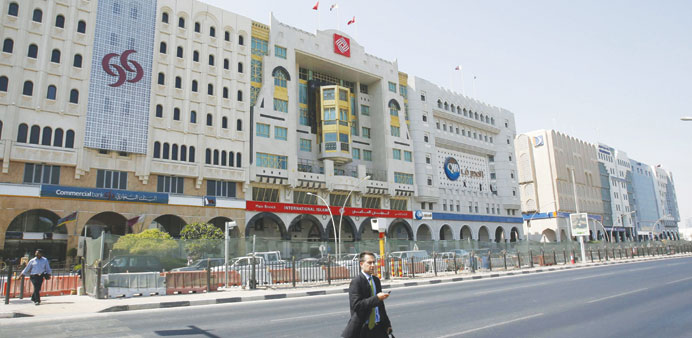|
Qatari lenders including Commercial Bank and Doha Bank are boosting profits by selling more debt and equities to investors as income from lending slows. |
Commercial Bank and Doha Bank’s gains from investment sales last quarter were the biggest for any first quarter since 2005, data compiled by Bloomberg shows. Commercial Bank, the second-biggest Qatari lender, reported a threefold rise in investment gains to 75.5mn riyals ($20.1mn) and Doha Bank’s more than doubled to 85.3mn riyals.
Sales of bonds, treasury bills and equities are helping make up for less profitable lending as the world’s biggest per capita economy slows. Qatari banks’ average net interest income growth, a measure of profit earned from lending, shrank to 1.5% last year from 18% in 2011, data compiled by Bloomberg show. Qatar holds Standard & Poor’s third-highest investment grade of AA. The yield on the country’s 5.75% bonds maturing in January 2042 narrowed about 37 basis points to 4.17% between March 25 and April 24, according to data compiled by Bloomberg.
“The yield on lending is coming down,” Raghavan Seetharaman, Doha Bank’s chief executive officer, told reporters in Doha on Tuesday. “But you have options in investment allocations, whether it is bonds or equities, where we managed to make it up.”
Qatar’s 11 domestic banks are competing in a market of 1.9mn people as economic growth slows to 5% this year after averaging 13% in the previous five years, according to forecasts compiled by Bloomberg.
Net interest income of Qatari lenders grew 1.5% last year compared to 10% growth in Saudi Arabia and 11% growth in Kuwait, the data shows.
Qatar plans to invest about $200bn in infrastructure, including a rail network, stadiums and a new port, prior to hosting the 2022 World Cup, though the “main impacts” aren’t expected for a couple of years, according to a 2011 report by the country’s 2011-2016 National Development Strategy.
Commercial Bank’s net interest income dropped 5% last quarter after rising in the fourth quarter, according to data compiled by Bloomberg. Doha Bank’s fell 5.4%, the fifth straight quarterly decline.
The Qatar Central Bank has been selling 4bn riyals of treasury bills a month to local banks since May 2011 to control liquidity and build a yield curve for domestic debt. Last month, the central bank sold its first instalment of quarterly three-and five-year bonds.
“Net interest margins remain under pressure because of liquidity in the system, loan re-pricing and relatively sticky deposit rates,” Abdullah Amin, senior research analyst at QNB Financial Services, said in an e-mail on April 17.
Interest earned on savings deposits in Qatari banks rose to 1.12% last year, from 1.06% in 2011, while interest on car loans fell to 5.44% from 6.18% and credit card rates dropped to 9.11% from 10.69%, according to central bank data.
“We buy equities, we buy fixed income corporates and sovereigns and try to make the most of it,” Seetharaman said. “If you have excess liquidity, you put it into T-bills and whenever you want to liquidate, you liquidate.”
Investment sales pushed up profits in the first quarter compared with the year-earlier period even as lending income fell. Commercial Bank’s first quarter profit rose 7% to 506mn riyals, beating the mean estimate of six analysts for a profit of 483mn riyals, data compiled by Bloomberg show. Doha Bank’s net income climbed 1.4% to 395.3mn riyals, beating the mean estimate of 5 analysts for a profit of 374mn riyals.
“They are selling securities,” Amin said. “Nobody could expect this big jump in investment gains. They can’t do it every quarter.”
Not all banks are earning less from lending. QNB, the Middle East’s biggest lender, earned a 7% first-quarter profit as net interest income rose 3.9%, according to data compiled by Bloomberg.
“We’re expecting a better second half in terms of loan growth,” Raja Ghoussoub, an analyst with NBK Capital, said in a telephone interview April 18. “Profitability in terms of net interest margins will still be subdued but should pick up in 3rd quarter.”
Bank profits were also helped by growth in fees and commissions earned from new loans and the refinancing of existing loans.
QNB’s net fees and commissions rose 3.9% to 350.2mn riyals, the biggest growth in four quarters. Commercial Bank’s net fee and commission income rose 27% to 162.9mn riyals. Fee and commission income at Doha Bank, Qatar’s fifth-biggest lender by assets, rose 13%.



